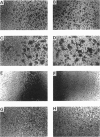Abstract
Monosomy 21 (M21) is a rare aneuploid condition which in certain cases leads to reduced levels of chromosome 21 gene products. We have prepared an Epstein-Barr virus lymphoblastoid cell-line (LCL) from patient with M21 who has immunological abnormalities, and analysed the expression of lymphocyte function-associated antigen-1 (LFA-1). This heterodimeric leucocyte integrin consists of CD11a (alpha) subunits non-covalently associated with CD18 (beta) subunits coded, respectively, by genes on chromosomes 16 and 21. To determine whether monosomy 21 results in decreased expression of LFA-1, monoclonal antibodies were used to compare the expression of CD11a and CD18 on the M21 LCL with LCL from trisomy 21 (Down's syndrome, T21), normal controls and a possible case of leucocyte adhesion deficiency. In addition, phorbol-ester-induced homotypic adhesion, an LFA-1-mediated effect, was compared in these LCLs. The results are consistent with a gene dosage mediated reduction of LFA-1 expression by the M21 LCL.
Full text
PDF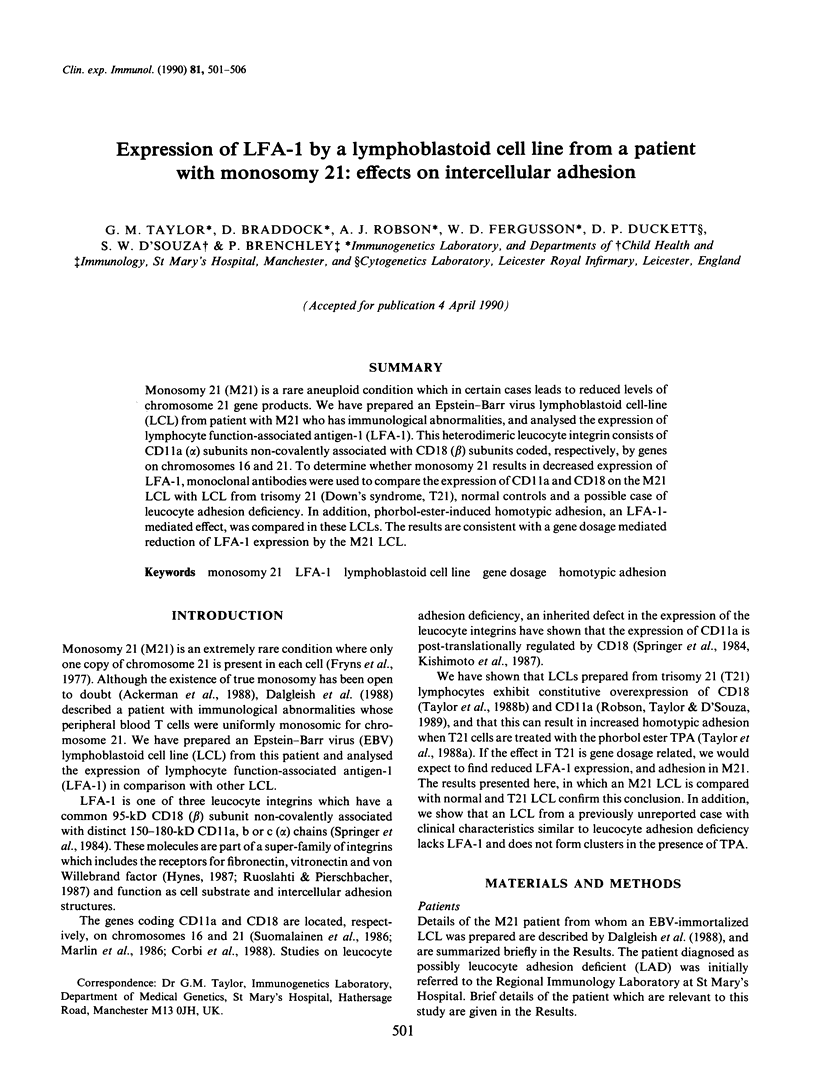
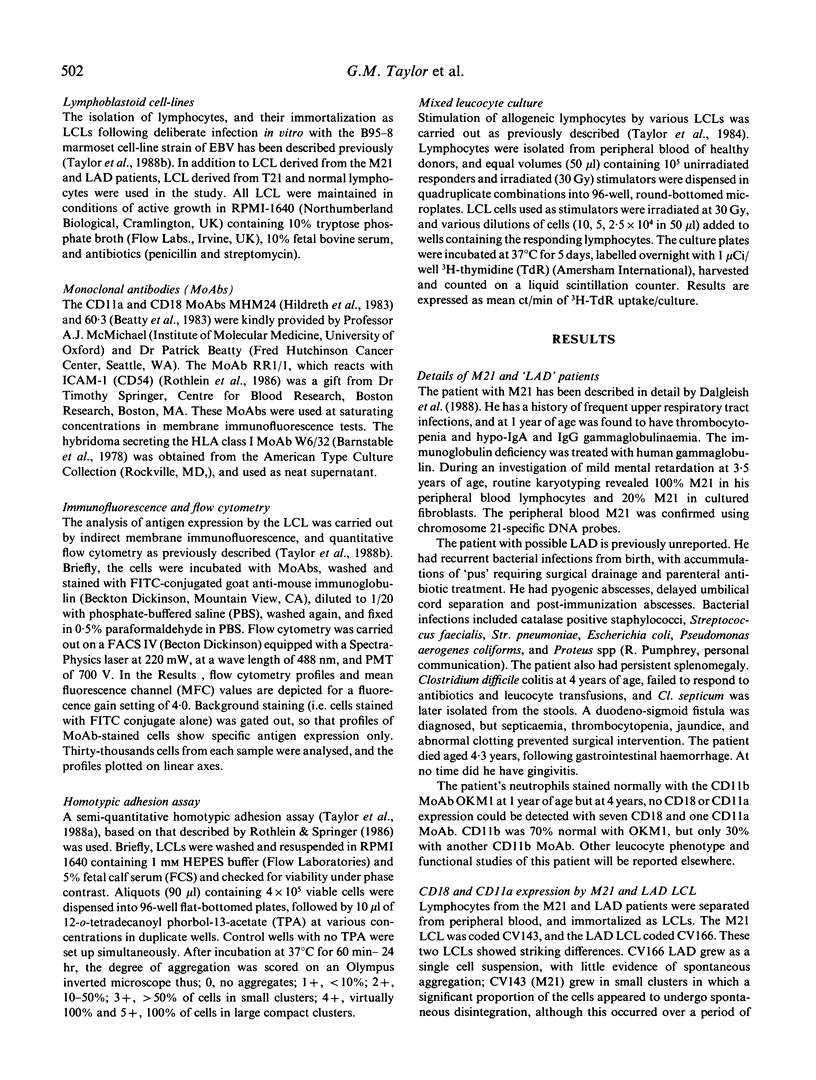
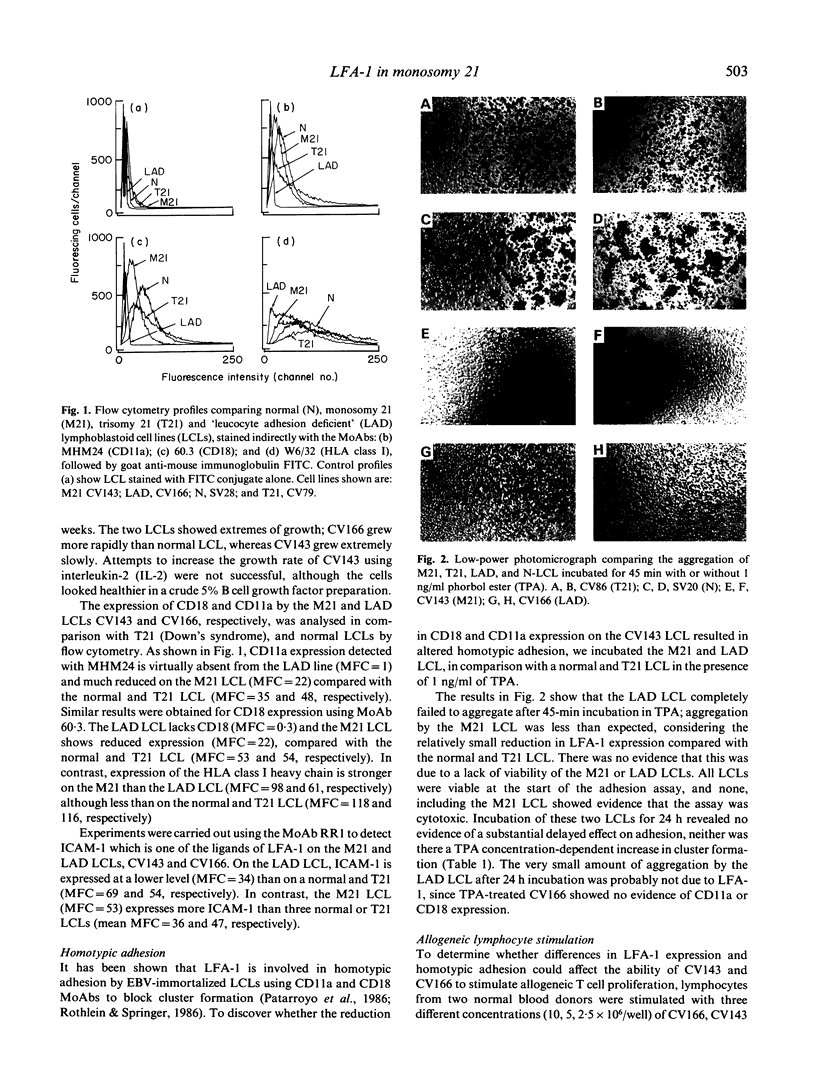
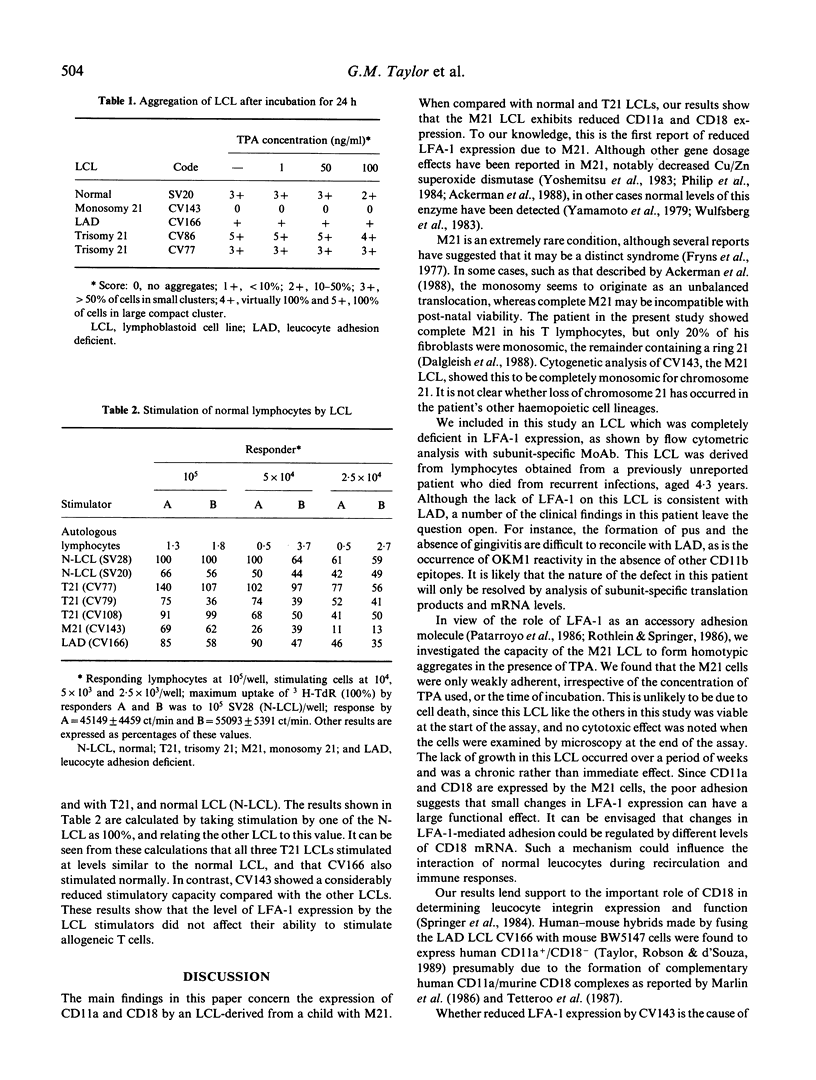
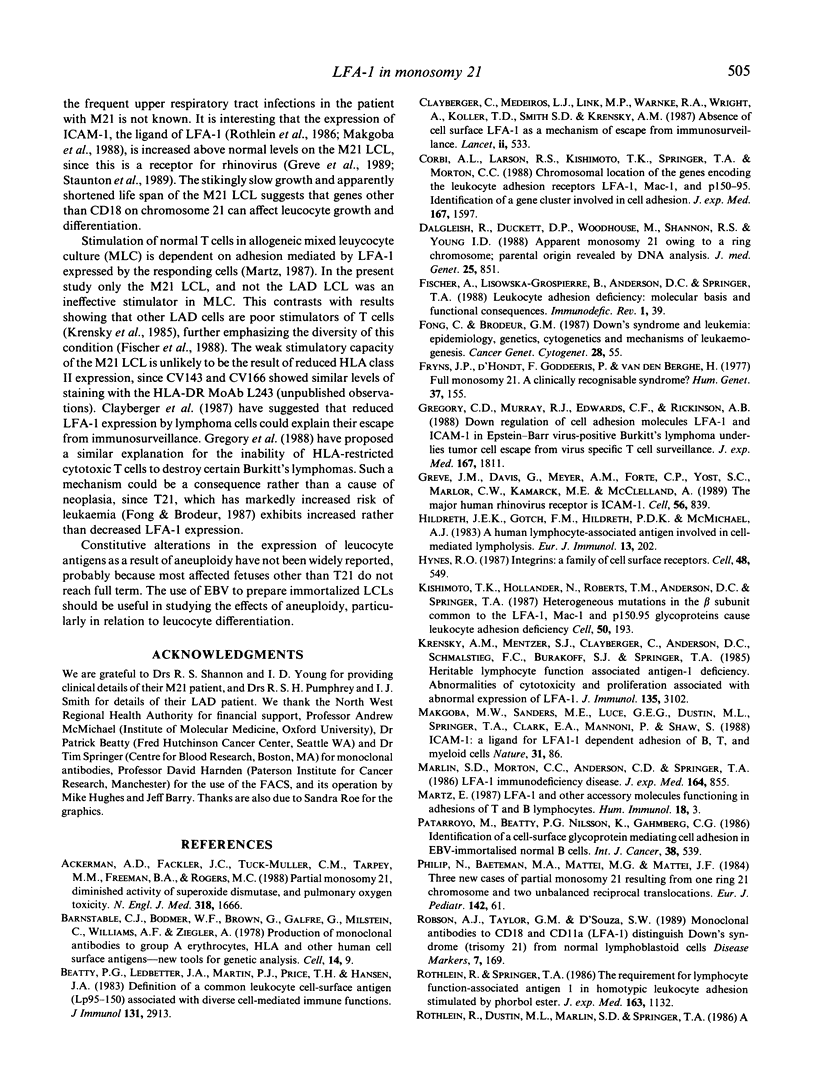
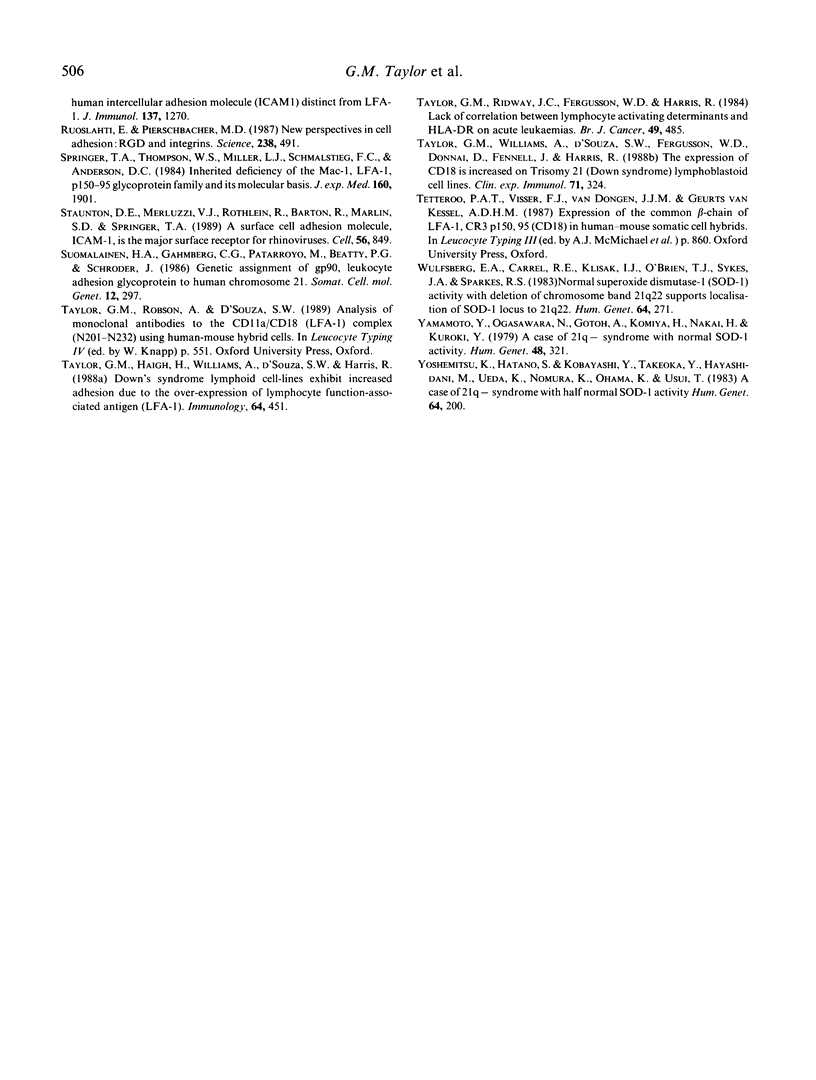
Images in this article
Selected References
These references are in PubMed. This may not be the complete list of references from this article.
- Ackerman A. D., Fackler J. C., Tuck-Muller C. M., Tarpey M. M., Freeman B. A., Rogers M. C. Partial monosomy 21, diminished activity of superoxide dismutase, and pulmonary oxygen toxicity. N Engl J Med. 1988 Jun 23;318(25):1666–1669. doi: 10.1056/NEJM198806233182506. [DOI] [PubMed] [Google Scholar]
- Barnstable C. J., Bodmer W. F., Brown G., Galfre G., Milstein C., Williams A. F., Ziegler A. Production of monoclonal antibodies to group A erythrocytes, HLA and other human cell surface antigens-new tools for genetic analysis. Cell. 1978 May;14(1):9–20. doi: 10.1016/0092-8674(78)90296-9. [DOI] [PubMed] [Google Scholar]
- Beatty P. G., Ledbetter J. A., Martin P. J., Price T. H., Hansen J. A. Definition of a common leukocyte cell-surface antigen (Lp95-150) associated with diverse cell-mediated immune functions. J Immunol. 1983 Dec;131(6):2913–2918. [PubMed] [Google Scholar]
- Clayberger C., Wright A., Medeiros L. J., Koller T. D., Link M. P., Smith S. D., Warnke R. A., Krensky A. M. Absence of cell surface LFA-1 as a mechanism of escape from immunosurveillance. Lancet. 1987 Sep 5;2(8558):533–536. doi: 10.1016/s0140-6736(87)92924-2. [DOI] [PubMed] [Google Scholar]
- Corbi A. L., Larson R. S., Kishimoto T. K., Springer T. A., Morton C. C. Chromosomal location of the genes encoding the leukocyte adhesion receptors LFA-1, Mac-1 and p150,95. Identification of a gene cluster involved in cell adhesion. J Exp Med. 1988 May 1;167(5):1597–1607. doi: 10.1084/jem.167.5.1597. [DOI] [PMC free article] [PubMed] [Google Scholar]
- Dalgleish R., Duckett D. P., Woodhouse M., Shannon R. S., Young I. D. Apparent monosomy 21 owing to a ring 21 chromosome: parental origin revealed by DNA analysis. J Med Genet. 1988 Dec;25(12):851–854. doi: 10.1136/jmg.25.12.851. [DOI] [PMC free article] [PubMed] [Google Scholar]
- Fischer A., Lisowska-Grospierre B., Anderson D. C., Springer T. A. Leukocyte adhesion deficiency: molecular basis and functional consequences. Immunodefic Rev. 1988;1(1):39–54. [PubMed] [Google Scholar]
- Fong C. T., Brodeur G. M. Down's syndrome and leukemia: epidemiology, genetics, cytogenetics and mechanisms of leukemogenesis. Cancer Genet Cytogenet. 1987 Sep;28(1):55–76. doi: 10.1016/0165-4608(87)90354-2. [DOI] [PubMed] [Google Scholar]
- Fryns J. P., D'Hondt F., Goddeeris P., van den Berghe H. Full monosomy 21: a clinically recognizable syndrome? Hum Genet. 1977 Jun 30;37(2):155–159. doi: 10.1007/BF00393578. [DOI] [PubMed] [Google Scholar]
- Gregory C. D., Murray R. J., Edwards C. F., Rickinson A. B. Downregulation of cell adhesion molecules LFA-3 and ICAM-1 in Epstein-Barr virus-positive Burkitt's lymphoma underlies tumor cell escape from virus-specific T cell surveillance. J Exp Med. 1988 Jun 1;167(6):1811–1824. doi: 10.1084/jem.167.6.1811. [DOI] [PMC free article] [PubMed] [Google Scholar]
- Greve J. M., Davis G., Meyer A. M., Forte C. P., Yost S. C., Marlor C. W., Kamarck M. E., McClelland A. The major human rhinovirus receptor is ICAM-1. Cell. 1989 Mar 10;56(5):839–847. doi: 10.1016/0092-8674(89)90688-0. [DOI] [PubMed] [Google Scholar]
- Hildreth J. E., Gotch F. M., Hildreth P. D., McMichael A. J. A human lymphocyte-associated antigen involved in cell-mediated lympholysis. Eur J Immunol. 1983 Mar;13(3):202–208. doi: 10.1002/eji.1830130305. [DOI] [PubMed] [Google Scholar]
- Hynes R. O. Integrins: a family of cell surface receptors. Cell. 1987 Feb 27;48(4):549–554. doi: 10.1016/0092-8674(87)90233-9. [DOI] [PubMed] [Google Scholar]
- Kishimoto T. K., Hollander N., Roberts T. M., Anderson D. C., Springer T. A. Heterogeneous mutations in the beta subunit common to the LFA-1, Mac-1, and p150,95 glycoproteins cause leukocyte adhesion deficiency. Cell. 1987 Jul 17;50(2):193–202. doi: 10.1016/0092-8674(87)90215-7. [DOI] [PubMed] [Google Scholar]
- Krensky A. M., Mentzer S. J., Clayberger C., Anderson D. C., Schmalstieg F. C., Burakoff S. J., Springer T. A. Heritable lymphocyte function-associated antigen-1 deficiency: abnormalities of cytotoxicity and proliferation associated with abnormal expression of LFA-1. J Immunol. 1985 Nov;135(5):3102–3108. [PubMed] [Google Scholar]
- Marlin S. D., Morton C. C., Anderson D. C., Springer T. A. LFA-1 immunodeficiency disease. Definition of the genetic defect and chromosomal mapping of alpha and beta subunits of the lymphocyte function-associated antigen 1 (LFA-1) by complementation in hybrid cells. J Exp Med. 1986 Sep 1;164(3):855–867. doi: 10.1084/jem.164.3.855. [DOI] [PMC free article] [PubMed] [Google Scholar]
- Martz E. LFA-1 and other accessory molecules functioning in adhesions of T and B lymphocytes. Hum Immunol. 1987 Jan;18(1):3–37. doi: 10.1016/0198-8859(87)90110-8. [DOI] [PubMed] [Google Scholar]
- Patarroyo M., Beatty P. G., Nilsson K., Gahmberg C. G. Identification of a cell-surface glycoprotein mediating cell adhesion in EBV-immortalized normal B cells. Int J Cancer. 1986 Oct 15;38(4):539–547. doi: 10.1002/ijc.2910380414. [DOI] [PubMed] [Google Scholar]
- Philip N., Baeteman M. A., Mattei M. G., Mattei J. F. Three new cases of partial monosomy 21 resulting from one ring 21 chromosome and two unbalanced reciprocal translocations. Eur J Pediatr. 1984 Apr;142(1):61–64. doi: 10.1007/BF00442594. [DOI] [PubMed] [Google Scholar]
- Robson A. J., Taylor G. M., D'Souza S. W. Monoclonal antibodies to CD18 and CD11A (LFA-1) distinguish Down's syndrome (trisomy 21) from normal lymphoblastoid cells. Dis Markers. 1989 Jul-Sep;7(3):169–180. [PubMed] [Google Scholar]
- Rothlein R., Dustin M. L., Marlin S. D., Springer T. A. A human intercellular adhesion molecule (ICAM-1) distinct from LFA-1. J Immunol. 1986 Aug 15;137(4):1270–1274. [PubMed] [Google Scholar]
- Rothlein R., Springer T. A. The requirement for lymphocyte function-associated antigen 1 in homotypic leukocyte adhesion stimulated by phorbol ester. J Exp Med. 1986 May 1;163(5):1132–1149. doi: 10.1084/jem.163.5.1132. [DOI] [PMC free article] [PubMed] [Google Scholar]
- Ruoslahti E., Pierschbacher M. D. New perspectives in cell adhesion: RGD and integrins. Science. 1987 Oct 23;238(4826):491–497. doi: 10.1126/science.2821619. [DOI] [PubMed] [Google Scholar]
- Springer T. A., Thompson W. S., Miller L. J., Schmalstieg F. C., Anderson D. C. Inherited deficiency of the Mac-1, LFA-1, p150,95 glycoprotein family and its molecular basis. J Exp Med. 1984 Dec 1;160(6):1901–1918. doi: 10.1084/jem.160.6.1901. [DOI] [PMC free article] [PubMed] [Google Scholar]
- Staunton D. E., Merluzzi V. J., Rothlein R., Barton R., Marlin S. D., Springer T. A. A cell adhesion molecule, ICAM-1, is the major surface receptor for rhinoviruses. Cell. 1989 Mar 10;56(5):849–853. doi: 10.1016/0092-8674(89)90689-2. [DOI] [PubMed] [Google Scholar]
- Suomalainen H. A., Gahmberg C. G., Patarroyo M., Beatty P. G., Schröder J. Genetic assignment of GP90, leukocyte adhesion glycoprotein to human chromosome 21. Somat Cell Mol Genet. 1986 May;12(3):297–302. doi: 10.1007/BF01570789. [DOI] [PubMed] [Google Scholar]
- Taylor G. M., Haigh H., Williams A., D'Souza S. W., Harris R. Down's syndrome lymphoid cell lines exhibit increased adhesion due to the over-expression of lymphocyte function-associated antigen (LFA-1). Immunology. 1988 Jul;64(3):451–456. [PMC free article] [PubMed] [Google Scholar]
- Taylor G. M., Ridway J. C., Fergusson W. D., Harris R. Lack of correlation between lymphocyte activating determinants and HLA-DR on acute leukaemias. Br J Cancer. 1984 Apr;49(4):485–494. doi: 10.1038/bjc.1984.76. [DOI] [PMC free article] [PubMed] [Google Scholar]
- Taylor G. M., Williams A., D'Souza S. W., Fergusson W. D., Donnai D., Fennell J., Harris R. The expression of CD18 is increased on Trisomy 21 (Down syndrome) lymphoblastoid cells. Clin Exp Immunol. 1988 Feb;71(2):324–328. [PMC free article] [PubMed] [Google Scholar]
- Yamamoto Y., Ogasawara N., Gotoh A., Komiya H., Nakai H., Kuroki Y. A case of 21q--syndrome with normal SOD-1 activity. Hum Genet. 1979 May 10;48(3):321–327. doi: 10.1007/BF00272832. [DOI] [PubMed] [Google Scholar]
- Yoshimitsu K., Hatano S., Kobayashi Y., Takeoka Y., Hayashidani M., Ueda K., Nomura K., Ohama K., Usui T. A case of 21q-syndrome with half normal SOD-1 activity. Hum Genet. 1983;64(2):200–202. doi: 10.1007/BF00327128. [DOI] [PubMed] [Google Scholar]



